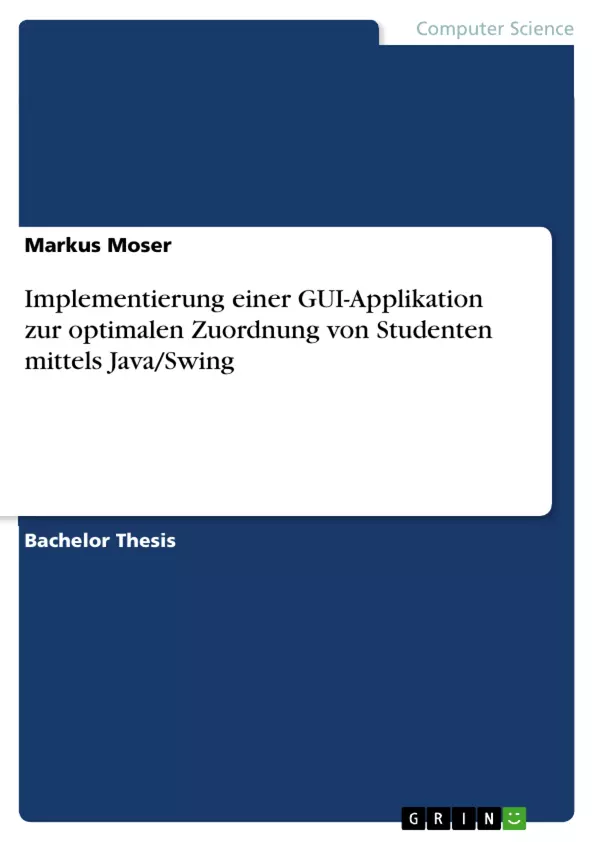JAssign is a Java-based application to assign students to topics of a university course according to their individual preferences used for ranking these
topics. Interaction with the program can be conducted over a graphical user
interface based on Swing which allows importing, exporting or modifying
the data and setting constraints for the optimization process. This bachelor
thesis documents the architecture and main functionality of the application.
It also provides a basic description of Java 's Swing toolkit.
Inhaltsverzeichnis (Table of Contents)
- Project description of JAssign
- Introduction
- System specifications
- Available legacy systems and resources
- Project schedule
- Project Milestones
- Structured plan
- Creation of a GUI with Java / Swing
- Basic description of Swing
- Commonly used widgets
- Implementation
- The class structure of JAssign
- External libraries used
- The datatype package
- The functions package
- The optimization package
- The user interface
- Conclusion
- Appendix
- The optimization model used
Zielsetzung und Themenschwerpunkte (Objectives and Key Themes)
The primary goal of this project is the development of a Java application, JAssign, designed to efficiently allocate students to project groups within university courses. JAssign utilizes a graphical user interface (GUI) built with the Swing toolkit, facilitating student preference input and optimized group assignments. This application is intended to address the complexities of group formation, particularly when student preferences, group size constraints, and potentially conflicting interests are involved.
- Development of a Java application for student assignment in university courses.
- Implementation of a graphical user interface based on the Swing toolkit for user interaction.
- Optimization of student group assignments based on individual preferences and constraints.
- Exploration of the Java Swing toolkit and its functionalities.
- Documentation of the application's architecture and functionality.
Zusammenfassung der Kapitel (Chapter Summaries)
The first chapter introduces JAssign, outlining the problem of student assignment in university courses where the number of topics is smaller than the number of students. It discusses the challenges posed by individual preferences, group size restrictions, and the need for a solution that avoids manual and time-consuming processes. Chapter 2 provides a basic description of the Swing toolkit and its commonly used widgets, forming the foundation for the GUI development in JAssign. Chapter 3 delves into the implementation details of JAssign, covering its class structure, external libraries used, and the architecture of various packages, including data types, functions, optimization algorithms, and the user interface. The conclusion chapter summarizes the project and its contribution to student assignment processes.
Schlüsselwörter (Keywords)
The primary focus of this project is on the development and implementation of a Java-based application for student assignment, incorporating a GUI built with Swing. Key themes include linear optimization, student preferences, and group allocation, with the application aiming to streamline and optimize the assignment process. The project also showcases the functionalities and application of the Java Swing toolkit in creating interactive and user-friendly interfaces.
- Quote paper
- MSc Markus Moser (Author), 2008, Implementierung einer GUI-Applikation zur optimalen Zuordnung von Studenten mittels Java/Swing , Munich, GRIN Verlag, https://www.grin.com/document/166912



